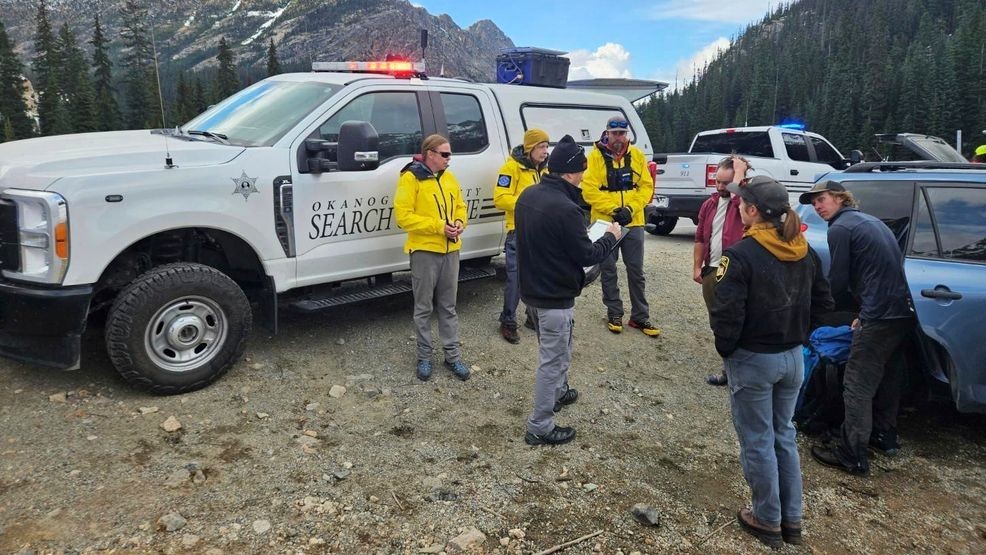OKANOGAN COUNTY, Wash. — The Okanogan County Coroner identified three King County climbers who died in a climbing accident in the North Cascades over the weekend.
The OCC identified the three climbers as Vishnu Irigireddy, 48, from Renton, Tim Nguyen, 63, from Renton, and Oleksander Martynenko, 36, from Bellevue. The OCC also identified the surviving climber as a 38-year-old man from Seattle.
The four climbers plummeted for about 200 feet Sunday into a slanted gulch and then tumbled another 200 feet before coming to rest, Okanogan County Undersheriff Dave Yarnell told the Associated Press. Authorities believe the group had been ascending but turned around when they saw a storm approaching.
The surviving climber extricated himself from a tangle of ropes, helmets and other equipment after the fall, hiked to his car in the dark and then drove to a pay phone to call for help. Yarnell said the man made the trek despite suffering internal bleeding and head trauma from the fall.
The group of four were scaling the Early Winters Spires, jagged peaks split by a cleft that is popular with climbers in the North Cascade Range.
ALSO SEE: 3 Renton climbers killed while rappelling in North Cascades
Authorities haven’t yet been able to interview the survivor, the coroner said, so much is still unknown of the fall and the man’s journey.
The group met with disaster when the anchor used to secure their ropes was torn from the rock while they were descending, Okanogan County Coroner Dave Rodriguez told the AP. The anchor they were using, a metal spike called a piton, appeared to have been placed there by past climbers, he said.
“The presumed cause of the accident is an anchor failure while rappelling,” the sheriff’s office wrote in a Facebook post, but the investigation is still ongoing.
Falls like this leading to three deaths are extremely rare, said Cristina Woodworth, who leads the sheriff’s search and rescue team. Seven years ago, two climbers were killed in a fall on El Capitan at Yosemite National Park in California.
A three-person search and rescue team reached the site of the fall Sunday, Woodworth said. The team used coordinates from a device the climbers had been carrying, which had been shared by a friend of the men.
Irigireddy, Nguyen and Martynenko were confirmed to be dead at the scene, the sheriff’s office said.
Once the search and rescue team found the site, they called in a Snohomish County Helicopter Rescue Team to remove the bodies one at a time because of the rough terrain, Woodworth said.
On Monday, responders poured over the recovered equipment trying to decipher what caused the fall, Woodworth said. They found a piton — basically a small metal spike that is driven into rock cracks or ice and used as anchors by climbers — that was still clipped into the climbers’ ropes.
“There’s no other reason it would be hooked onto the rope unless it pulled out of the rock,” said Rodriguez, the coroner, noting that pitons are typically stuck fast in the rock. Rodriguez added that when rappelling, all four men would not have been hanging from the one piton at the same time, but taking turns moving down the mountain.
Pitons are oftentimes left in walls. They can be there for years or even decades, and they may become less secure over time.
“It looked old and weathered, and the rest of their equipment looked newer, so we are making the assumption that it was an old piton,” Woodworth said.
Rock climbers secure themselves by ropes to anchors, such as pitons or other climbing equipment. The ropes are intended to arrest their fall if they should slip, and typically climbers use backup anchors, said Joshua Cole, a guide and co-owner of North Cascades Mountain Guides, who has been climbing in the area for about 20 years.
Generally, it would be unusual to rappel off a single piton, said Cole, adding that it is still unknown exactly what happened on the wall that night.
“We eventually, if possible, would like to get more information from surviving party,” Woodworth said.
The spires are a popular climbing spot. The route the climbers were taking, said Cole, was of moderate difficulty, and requires moving between ice, snow and rock.
But the conditions, the amount of ice versus rock for example, can change rapidly with the weather, he said, even week to week or day to day, changing the route’s risks.


